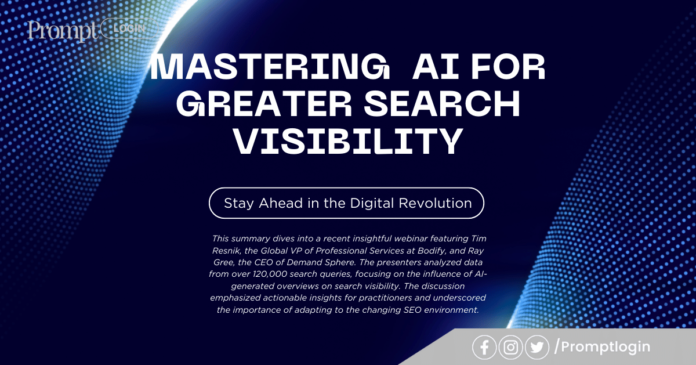Introduction
In the rapidly evolving landscape of search engine optimization (SEO), understanding the impact of artificial intelligence (AI) on search visibility is crucial for marketers and digital strategists. This summary dives into a recent insightful webinar featuring Tim Resnik, the Global VP of Professional Services at Bodify, and Ray Gree, the CEO of Demand Sphere. The presenters analyzed data from over 120,000 search queries, focusing on the influence of AI-generated overviews on search visibility. The discussion emphasized actionable insights for practitioners and underscored the importance of adapting to the changing SEO environment.
Center
Webinar Highlights
- Data Analysis Focus: The presenters utilized a comprehensive analysis of 120,000 search queries to evaluate when AI overview snippets appear and the associated effects on search performance.
- Key Poll Insights:
- A significant 82% of attendees expressed confidence in the future of SEO, indicating optimism despite recent trends showcasing declines in click-through rates.
- Understanding AI Overview Influence:
- The emergence of AI overviews represents a new feature within search results, essentially creating a secondary SERP (Search Engine Results Page).
- In 2023 alone, Google made an astonishing 5,000 changes to search features, highlighting the dynamic nature of search engine algorithms.
The Modern SERP
- SERP Feature Explosion: Search engines now incorporate over 300 features, making it essential for SEO strategists to stay abreast of how each affects user engagement.
- Traditional Metrics: While Google Search Console remains an invaluable tool for tracking keywords, practitioners must look beyond basic metrics to fully grasp AI’s impact.
Pixel Depth and Visual Impact
- The anatomy of an AI overview spans an average pixel height of about 400 pixels, significantly impacting where traditional organic results are displayed.
- Combining this with featured snippets can result in well over 600 pixels of visual content above organic search results, meaning lower-ranked listings face an uphill battle for visibility.
Keyword Intent Categories:
- Commercial vs. Informational: Understanding the difference in intent demonstrates that informational queries yield higher AI appearances compared to commercial keywords.
- The study indicated that long-tail keywords, especially in informational contexts, provide a greater chance to encounter AI overview presentations.
Adapting Strategy:
- 70% of AI overviews pull from organic ranking citations in positions 12 or higher, maintaining the relevance of traditional SEO practices.
- Employing practices such as focusing on semantic relevance, utilizing schema markup, improving page load speeds, and ensuring effective crawlability are all critical.
| Aspect | Detail |
|---|---|
| AI Overview Pixel Height | Approx. 400 pixels for AI overviews, 240 pixels for featured snippets. |
| Keyword Intent Categories | Higher rates for Informational queries and long-tail keywords. |
| Visibility Factors | Links predominantly sourced from ranks 12+. |
Use of Cosine Similarity:
- Understanding the cosmic similarity score correlates between generated AI overview text and their underlying citation links, leading to insights on optimizing content for visibility.
Outro
As the SEO landscape continues to shift under the influence of AI technologies and evolving consumer behaviors, marketers and SEO professionals must rapidly adapt to maintain visibility and lead in their respective industries. The growth of AI overview features in SERPs calls for a proactive approach in crafting content that aligns with emerging trends while maintaining traditional SEO fundamentals.
In conclusion, the insights shared by Tim and Ray in the webinar pinpoint actionable strategies to maximize search visibility by leveraging data-driven approaches, emphasizing user intent, and adapting to the intricate workings of modern SERPs. For SEO professionals, this promising landscape offers not just challenges but myriad opportunities for growth and innovation.
Everyone looking for a competitive edge in search must embrace these changes thoughtfully, continually adapt, and stay informed with data, as the pie of search capabilities expands.



